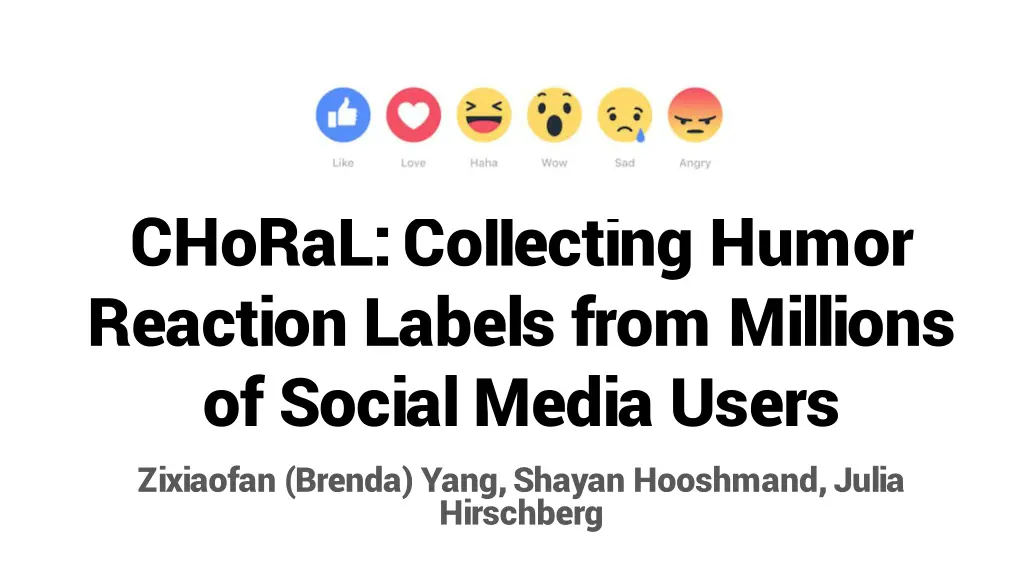
Humor Reaction Labels and Dataset Analysis
Explore the research on defining humor, collecting humor reactions, and analyzing datasets from social media users. Learn about scoring frameworks, defining humor and non-humorous scores, and classification experiments. Discover how non-humorous posts are defined for binary classification, using humor scores inversely. Explore the complexities of annotating humor and its culture-specific nature.
Download Presentation

Please find below an Image/Link to download the presentation.
The content on the website is provided AS IS for your information and personal use only. It may not be sold, licensed, or shared on other websites without obtaining consent from the author. If you encounter any issues during the download, it is possible that the publisher has removed the file from their server.
You are allowed to download the files provided on this website for personal or commercial use, subject to the condition that they are used lawfully. All files are the property of their respective owners.
The content on the website is provided AS IS for your information and personal use only. It may not be sold, licensed, or shared on other websites without obtaining consent from the author.
E N D
Presentation Transcript
CHoRaL: Collecting Humor Reaction Labels from Millions of Social Media Users Zixiaofan (Brenda) Yang, Shayan Hooshmand, Julia Hirschberg
How to define humor? Receiver Laughter? Other approbation? Producer Intent?
How to define humor? Receiver Laughter? Other approbation? Producer Intent? Hard to annotate! Highly individualistic and culture-specific
Outline I. Scoring Framework A. Defining Humor Score B. Defining Non-Humorous Score II. Collecting our Dataset III. Humor Analysis on our Dataset IV. Model Classification Experiments V. Future Work & Limitations
Defining Humor Score Higher percentage of humor reactions -> higher humor score Discount unpopular posts
Defining Humor Score Higher percentage of humor reactions -> higher humor score Discount unpopular posts h = # of humor reactions, t = total # of reactions
How do we define non-humorous post? Need to retrieve non-humorous samples for binary classification Use opposite of humor score?
How do we define non-humorous post? Need to retrieve non-humorous samples for binary classification Use opposite of humor score?
How do we define non-humorous post? Need to retrieve non-humorous samples for binary classification Use opposite of humor score?
How do we define non-humorous post? Need to retrieve non-humorous samples for binary classification Use opposite of humor score?
Defining Non-Humor Score (NS) Reaction distribution more similar to average facebook post -> more non- humorous Assumption: average facebook post is not humorous
Defining Non-Humor Score (NS) Use KL-divergence of post s reaction distribution from average post reaction distribution R = set of FB reactions S = % of reaction r in the standard distribution O = % of reaction r in the observed post t = total # of reacts 50 = popularity stretcher
Dataset Collected using CrowdTangle, a FB insights tool 2M posts retrieved with: Keywords: covid, covid-19, coronavirus, corona, covid 19, sars-cov-2, covid, sars cov 2 Language: English Type: Text-only Time Range: Jan 2020-Mar 2021 785K after cleaning; removed posts with duplicate fields rendered links >500 characters Covid-related FB posts Language: English Post type: text-only
Dataset High HS High NS
Humor Analysis Humorous one-liners (Mihalcea and Pulman, 2007) Negative polarity, Human-centeredness Our humorous posts have Human centeredness: singular first-person pronouns, total pronouns Negative polarity: anger words, negations, negative sentiment Less detailed and more abstract writing style Lower complexity
Humor Analysis -Examples from LIWC Analysis Positive Correlation Negative Correlation Categories: Categories: Words: Pronouns ( I , Personal Pronouns ) Informal Language ( Swear ) and Anger Sexual Words: I my They they re he it F*** shit bitch c**t dumbf*** Anal blowjob chlamydia Zombie Relativity ( Time , Space ) Prepositions Work Death Death total of new (Total of new cases/deaths ?) County health positive today
Humor Analysis -Emoji Humorous posts have more emojis 363 of the 1,621 unique emojis are significantly correlated with humor Most humorous emoji: ``Face with Tears of Joy'' Humorous posts have fewer heart emojis , but more broken hearts Negative polarity
Model Experiments Experiment settings Continuous Binary Models RoBERTa-base BERTweet: RoBERTa + Tweet BERTweet-covid: BERTweet + 23M COVID-related Tweets Human labels Labels used not as gold standard, but as a baseline Continuous HS is used as ground truth of humor Positive: High HS posts; Negative: High NS posts
Future Work & Limitations Only covid-19 related data, but easy to expand! Are we annotating perception or intent? And whose perception? Use other reactions, like sad and mad , for collecting new datasets Receiver Laughter? Other approbation? Produce r Intent?
Acknowledgments Brenda Yang, Julia Hirschberg, and the Speech Lab, of course! Slides adapted from my 2021 Lab Talk and Brenda s 2021 EMNLP talk
